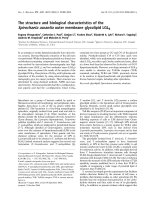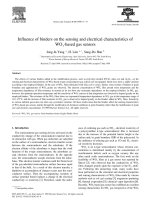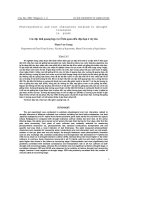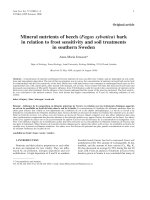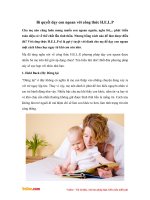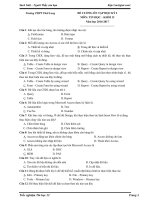Adapting the hydrologic evaluation of landfill performance (h e l p) model to the climatic and soil characteristics of queensland
Bạn đang xem bản rút gọn của tài liệu. Xem và tải ngay bản đầy đủ của tài liệu tại đây (2.32 MB, 175 trang )
This is the author’s version of a work that was submitted/accepted for publication in the following source:
Bauerle, Markus
(2016)
Adapting the Hydrologic Evaluation of Landfill Performance (H. E. L. P)
model to the climatic and soil characteristics of Queensland.
Masters by Research
thesis,
Queensland University of Technology.
This file was downloaded from: />
Notice: Changes introduced as a result of publishing processes such as
copy-editing and formatting may not be reflected in this document. For a
definitive version of this work, please refer to the published source:
ADAPTING THE HYDROLOGIC
EVALUATION OF LANDFILL
PERFORMANCE (H.E.L.P.) MODEL TO
THE CLIMATIC AND SOIL
CHARACTERISTICS OF QUEENSLAND
Markus Bauerle
Bachelor of Applied Science
Submitted in fulfilment of the requirements for the degree of
Master of Applied Science (Research)
School of Earth, Environmental and Biological Sciences
Science and Engineering Faculty
Queensland University of Technology
2016
Keywords
HELP
WGEN
Leachate
Landfill Design
Synthetic Weather Generation
Water Balance
Soil Hydrological Properties
Queensland
Adapting the Hydrologic Evaluation of Landfill Performance (H.E.L.P.) Model to the Climatic and
Soil Characteristics of Queensland
i
Abstract
Leachate, liquid that percolates through waste contained within a solid waste
landfill, can pose a threat to the environment and public health if it’s allowed to
reach or surface- or groundwater aquifers. Proper management of leachate can
mitigate this risk.
The Hydrological Evaluation of Landfill Performance (HELP) model is a tool
that can be used to assess the potential of a given landfill design to produce leachate.
However the HELP model was designed specifically for use in the U.S. and only
includes data applicable to U.S. locations. To ensure simulation results are as
accurate as possible, local weather and soil data are required as inputs in the model.
The goal of this thesis was to obtain the required soil and weather data and
make them accessible for use within the HELP model, through a new graphical user
interface. The structure of the research presented in the following thesis is based
around the research question: “How can the HELP model best be adapted to
adequately simulate the water balance of solid waste landfills in Queensland?”
To adapt the weather generator, WGEN, new stochastic precipitation,
temperature and solar radiation parameters are required. These parameters have been
calculated for twenty-one locations around Queensland, utilizing the historical
record.
To accurately reflect the hydrologic properties of Queensland soils a new
dataset is required. Soil hydrological data were obtained from the literature and
grouped into several textural classes, representative of Australian soils. A
representative value for each available textural class was then calculated from the
dataset.
To enable the use of the HELP model in modern computing environments and
to allow for the use of the new weather and soil data, a new HELP graphical user
interface was built, from scratch The GUI is based on the design of the original
HELP interface, resulting in a modern user friendly interface. The functionality of
the interface was demonstrated in synthetic case study. A HELP model specifically
adapted to Australian soil and climatic conditions will help to ensure that regulatory
ii
Adapting the Hydrologic Evaluation of Landfill Performance (H.E.L.P.) Model to the Climatic and
Soil Characteristics of Queensland
requirements related to the design of new landfills or hydrologic assessment of
existing landfills can be met in the most stringent manner.
The primary outcome of this research is the creation of a new HELP model
interface which contains the new weather and soils data and will be available to
stakeholders as a shareware tool.
Adapting the Hydrologic Evaluation of Landfill Performance (H.E.L.P.) Model to the Climatic and
Soil Characteristics of Queensland
iii
Table of Contents
Keywords ............................................................................................................................. i
Abstract ............................................................................................................................... ii
Table of Contents................................................................................................................ iv
List of Figures .................................................................................................................... vi
List of Tables .................................................................................................................... viii
List of Abbreviations ........................................................................................................... x
Statement of Original Authorship ........................................................................................ xi
Acknowledgements ............................................................................................................ xii
Chapter 1:
Landfills and Solid Waste Management ....................................... 1
1.1
Introductory Statement ............................................................................................... 1
1.2
Landfill Disposal........................................................................................................ 1
1.2.1 A short history of modern landfills and waste management............................... 2
1.2.2 Design of modern landfills ............................................................................... 3
1.2.3 Landfill design, waste management and regulation in Queensland and
Australia .......................................................................................................... 5
1.3
Leachate .................................................................................................................... 9
1.4
Calculating Leachate Generation Rates .................................................................... 12
1.4.1 Water balance ................................................................................................ 12
1.4.2 Water balance method .................................................................................... 13
1.4.3 Hydrologic models currently used to evaluate Australian landfills .................. 13
1.5
The HELP Model ..................................................................................................... 15
1.5.1 HELP method of solution ............................................................................... 17
1.5.2 WGEN ........................................................................................................... 19
1.5.3 Development and Validations of the HELP Model.......................................... 24
1.5.4 HELP program execution ............................................................................... 26
1.6
The Queensland context ........................................................................................... 28
1.6.1 Adapting the HELP model to Queensland....................................................... 29
1.7
Objectives and Research Problem ............................................................................ 32
Chapter 2:
Weather ........................................................................................ 35
2.1
Introduction: ............................................................................................................ 35
2.2
Parameter Generation:.............................................................................................. 36
2.2.1 Precipitation parameters ................................................................................. 38
2.2.2 Temperature and solar radiation parameters .................................................... 42
2.3
Sources of Data ........................................................................................................ 51
2.4
Precipitation Parameters ........................................................................................... 55
2.4.1 Discussion of precipitation results .................................................................. 61
2.5
Temperature and Solar Radiation Parameters ........................................................... 64
2.6
Conclusions: ............................................................................................................ 69
2.6.1 Further work .................................................................................................. 70
iv
Adapting the Hydrologic Evaluation of Landfill Performance (H.E.L.P.) Model to the Climatic and
Soil Characteristics of Queensland
Chapter 3:
Soils ............................................................................................... 71
3.1
Introduction ............................................................................................................. 71
3.1.1 Background on the required values ................................................................. 72
3.1.2 Soil classification ........................................................................................... 74
3.2
Methods ................................................................................................................... 77
3.2.1 Data Analysis ................................................................................................. 78
3.3
Results ..................................................................................................................... 82
3.3.1 Final values .................................................................................................... 84
3.4
Discussion:............................................................................................................... 87
3.4.1 Justification for choice of final values: ............................................................ 87
3.4.2 Comparison with U.S. data ............................................................................. 87
3.4.3 Limitations ..................................................................................................... 89
Chapter 4:
H.E.L.P. Program Modification .................................................. 91
4.1
Introduction ............................................................................................................. 91
4.1.1 Technical considerations ................................................................................ 91
4.2
HELP Interface Design............................................................................................. 94
4.2.1 Weather interface ........................................................................................... 95
4.2.2 Soils and design interface ............................................................................. 100
4.3
Conclusions: .......................................................................................................... 111
4.3.1 Further work: ............................................................................................... 112
Chapter 5:
Landfill Design Case Study ........................................................ 115
5.1
Introduction ........................................................................................................... 115
5.2
Landfill sizing ........................................................................................................ 115
5.2.1 Final Landfill Size ........................................................................................ 116
5.3
Input data into the landfill design............................................................................ 117
5.3.1 Weather data ................................................................................................ 117
5.3.2 Soils data...................................................................................................... 118
5.3.3 Design of the landfill .................................................................................... 121
5.4
Results and discussion ............................................................................................ 122
5.4.1 Discussion .................................................................................................... 123
Chapter 6:
6.1
Final Discussion .......................................................................... 125
Final Discussion ..................................................................................................... 125
6.1.1 Comparison with other versions of HELP ..................................................... 127
6.1.2 Recommendations for Further Research........................................................ 128
Chapter 7:
Conclusions ................................................................................. 131
Bibliography ........................................................................................................ 135
Appendices .......................................................................................................... 141
Weather Data Corrections……………………………………………… Enclosed CD-ROM
Adapting the Hydrologic Evaluation of Landfill Performance (H.E.L.P.) Model to the Climatic and
Soil Characteristics of Queensland
v
List of Figures
Figure 1: Standard Design of a MSW Landfill (O'Leary et al., 1995) ........................ 4
Figure 2: Two design alternatives for landfill caps (Environmental Protection
Agency Victoria, 2010) ............................................................................... 5
Figure 3: Landfill liners and drainage system designs. Best available
technology (left) and commonly available technology (right)
(Environmental Protection Agency Victoria, 2010). .................................... 6
Figure 4: Example landfill design in HELP (Schroeder, Lloyd, et al., 1994) ........... 16
Figure 5: HELP program overview (Taulis, 2002) .................................................. 26
Figure 6: Modified Köppen classification for Australia, with locations for
weather parameter generation.................................................................... 29
Figure 7: The shape parameter ................................................................................ 40
Figure 8: The scale parameter ................................................................................. 40
Figure 9: Locations for parameter calculation with the major classes of the
modified Köppen classification ................................................................. 58
Figure 10: Gamma density distributions created from parameters for Cooktown
and Brisbane during the month of February............................................... 62
Figure 11: Ternary diagram showing the limits of texture classes of the
Australian and ISSS classification systems (ISSS texture classes are
shown in black, the Australian classification is shown in red). *Sa =
Sand; Lo = Loam; Si =Silt; Cl = Clay ....................................................... 76
Figure 12: Distribution of available data in the texture triangle of the ISSS
classification: ............................................................................................ 78
Figure 13: Distribution of available data in the texture triangle of the Australian
classification ............................................................................................. 79
Figure 14: Schematic of the structure of the original HELP interface
(Schroeder, Lloyd, et al., 1994) ................................................................. 94
Figure 15: Schematic of the weather data module in the original HELP user
interface (Schroeder, Lloyd, et al., 1994)................................................... 95
Figure 16: The evapotranspiration data window of the new HELP interface ........... 96
Figure 17: The precipitation, temperature, and solar radiation data window of
the new HELP interface ............................................................................ 97
Figure 18: The precipitation correction window of the new HELP interface ........... 98
Figure 19: The save data window of the new HELP interface ................................. 99
Figure 20: Schematic of the soils data module in the original HELP user
interface (Schroeder, Lloyd, et al., 1994)................................................. 100
Figure 21: The landfill general information window of the new HELP interface ... 101
Figure 22: The landfill design window of the new HELP interface ....................... 102
vi
Adapting the Hydrologic Evaluation of Landfill Performance (H.E.L.P.) Model to the Climatic and
Soil Characteristics of Queensland
Figure 23: The define layer window of the new HELP interface ............................ 103
Figure 24: The Select Soil or Material window of the new HELP interface ........... 104
Figure 25: The runoff curve number window of the new HELP interface .............. 106
Figure 26: Ternary diagram showing the Australian and USDA textural
classification systems (USDA texture classes are shown in black, the
Australia classification is shown in blue). ................................................ 107
Figure 27: The execute simulation window of the new HELP interface ................. 108
Figure 28: Sample output of the HELP model, showing a monthly summary
output. ..................................................................................................... 109
Figure 29: Best practice landfill liner design recommended by Victorian
guidelines (EPA Victoria, 2010) .............................................................. 121
Adapting the Hydrologic Evaluation of Landfill Performance (H.E.L.P.) Model to the Climatic and
Soil Characteristics of Queensland
vii
List of Tables
Table 1: Leachate Profile derived from four Australian Landfills (values in
mg/L unless indicated) (Scott et al., 2005)................................................. 11
Table 2: Required data files for simulation using help3o.exe .................................. 27
Table 3: Required data from each location .............................................................. 30
Table 4: Required input data for the parameter generation procedure ...................... 36
Table 5: Sources of data and length of data record used for the parameter
generation ................................................................................................. 53
Table 6: Solar radiation sources of data and length of data record for locations
were solar radiation data was obtained from a different station to
temperature data........................................................................................ 53
Table 7: Percentage of data completeness ............................................................... 54
Table 8: Precipitation Generation Parameters ......................................................... 56
Table 9: Comparison of Historic and Synthetic Precipitation Data .......................... 60
Table 10: The Temperature and Solar Radiation Parameters ................................... 64
Table 11: A Matrices .............................................................................................. 65
Table 12: B Matrices .............................................................................................. 66
Table 13: The lag 0 correlation coefficients ............................................................ 66
Table 14: The lag 1 correlation coefficients ............................................................ 67
Table 15: Comparison of Historic and Synthetic Temperature and Solar
Radiation Data .......................................................................................... 68
Table 16: Required soil hydrological data inputs..................................................... 72
Table 17: Range of values for saturated hydraulic conductivity in Australian
soil (Geeves et al., 2007) ........................................................................... 73
Table 18: Particle size limits of the Australian and USDA textural
classification systems (Minasny & McBratney, 2001) ............................... 75
Table 19: Datasets used to obtain the soil hydrological data and sample size per
dataset....................................................................................................... 78
Table 20: Results of soil data analysis with data sorted into the groups of the
Australian textural classification system. ................................................... 81
Table 21: Results of soil data analysis with data sorted into the groups of the
ISSS textural classification system. ........................................................... 81
Table 22: Results of W test and data transformation presented for data in the
Australian classification ............................................................................ 83
Table 23: Results of W test and data transformation presented for data in the
ISSS classification .................................................................................... 83
viii
Adapting the Hydrologic Evaluation of Landfill Performance (H.E.L.P.) Model to the Climatic and
Soil Characteristics of Queensland
Table 24: Final values for the texture classes of the Australian classification........... 84
Table 25: Final values for the texture classes of the ISSS classification ................... 84
Table 26: U.S. data presented in the USDA classification ....................................... 85
Table 27: Weather data file extensions .................................................................... 99
Table 28: Required files for simulation and their extensions .................................. 108
Table 29: Projected population of Samford valley from 2011 to 2036 ................... 116
Table 30: Mt. Glorious Fahey Rd station monthly averages of precipitation and
temperature ............................................................................................. 117
Table 31: Highest 5-day precipitation amounts from synthetic and historic data .... 118
Table 32: Results of particle size analysis for data collected from SERF ............... 119
Table 33: Results of soil hydrological testing and average values for the A and
B horizons ............................................................................................... 120
Table 34: Comparisons of the A and B horizons with collected Australian soil
data ......................................................................................................... 120
Table 35: Layers of the landfill design as required by HELP ................................. 122
Table 36: Monthly HELP simulation output for January. All data in mm ............... 123
Table 37: Monthly HELP simulation output for February. All data in mm ............. 123
Adapting the Hydrologic Evaluation of Landfill Performance (H.E.L.P.) Model to the Climatic and
Soil Characteristics of Queensland
ix
List of Abbreviations
HELP
Hydrological Evaluation of Landfill Performance
WGEN
Weather Generator
MSW
Municipal Solid Waste
GUI
Graphical User Interface
T max
Maximum Temperature
T min
Minimum Temperature
ISSS
International Soil Science Society
K sat
Saturated Hydraulic Conductivity
SERF
Samford Ecological Research Facility
x
Adapting the Hydrologic Evaluation of Landfill Performance (H.E.L.P.) Model to the Climatic and
Soil Characteristics of Queensland
Statement of Original Authorship
The work contained in this thesis has not been previously submitted to meet
requirements for an award at this or any other higher education institution. To the
best of my knowledge and belief, the thesis contains no material previously
published or written by another person except where due reference is made.
Signature:
QUT Verified Signature
Date:
May 2016
Adapting the Hydrologic Evaluation of Landfill Performance (H.E.L.P.) Model to the Climatic and
Soil Characteristics of Queensland
xi
Acknowledgements
I would like to offer my gratitude to a few people who have supported me
through my research journey
Firstly, I would like to thank my Principal Supervisor, Dr. Mauricio Taulis, for
giving me the opportunity to pursue this research and for his support and guidance
throughout my candidature.
I would also like to thank my Associate Supervisor, Dr. Clemens Scheer, for
his support with the soils related portion of my research and for taking over as the
Principal Supervisor for the final two months of my candidature.
Last but not least, I would like to thank my parents, Manfred and Petra, and my
partner Cecilia, who have supported me unconditionally and without whom I would
not have been able to complete this project.
xii
Adapting the Hydrologic Evaluation of Landfill Performance (H.E.L.P.) Model to the Climatic and
Soil Characteristics of Queensland
Chapter 1: Landfills and Solid Waste
Management
1.1
INTRODUCTORY STATEMENT
The Hydrologic Evaluation of Landfill Performance (HELP) model is the
predominant tool used to model water balance and estimate leachate production in
sanitary landfills in North America (Xu, Kim, Jain, & Townsend, 2012) and in many
countries around the world (Berger, 2013). The HELP model was developed by the
U.S. Army Corps of Engineers (USACE) for the United States Environmental
Protection Agency. The latest software version (version 3.07) of the HELP model
was released by the USACE’s Environmental Laboratory in November 1997. The
program is designated as shareware and is therefore freely available without any
Intellectual Property restrictions. Version 3.07 of the HELP model is a DOS program
designed for 16-bit computers, and will not run in modern 64-bit computing
environments. In addition, this version of the model only includes default US soil
and weather data which are not directly applicable to other regions apart from the
US.
1.2
LANDFILL DISPOSAL
Landfill disposal of municipal solid waste (MSW) is the most common
disposal method in most countries (Kjeldsen et al., 2002) and is also the most
common disposal method in Australia (Scott, Beydoun, Amal, Low, & Cattle, 2005).
The design and operation of a landfill possesses numerous environmental and
societal challenges, including the management of landfill gas, the management of
landfill leachate in the context of local groundwater and surface water resources, the
need to reduce pests that may be attracted to waste, as well as the attitude of
communities residing in the vicinity of the landfill (O'Leary et al., 1995). Modern
landfills use containment systems to control the movement of liquid and gas in and
out of the landfill. To restrict the movement of liquid, hydraulic barriers are
employed, both on top of the waste, to control the infiltration of precipitation and
Chapter 1: Landfills and Solid Waste Management
1
below the waste to stop contaminated liquid, which is termed leachate (Albright,
Benson, & Waugh, 2010).
Landfill disposal is a convenient and economic method of waste disposal, but
unsuitable management can lead to contamination of the surrounding environment,
particularly ground and surface waters (Scott et al., 2005). A modern sanitary landfill
is an engineered solution ensuring the efficient and environmentally safe disposal of
waste (Yalcin & Dermirer, 2002). The design of a sanitary landfill is a carefully
considered process that involves the complete management of all aspects of waste
disposal. An engineered sanitary landfill allows for the collection of methane, as well
as leachate, thus allowing for the comprehensive protection of the surrounding
environment.
1.2.1 A short history of modern landfills and waste management
The concept of a sanitary landfill first emerged during the 1930’s, in response
to heightened public awareness of leachate contamination threatening public health.
Prior to this time, landfills were essentially open pits. The main developments during
this time were the use of a daily soil cover, to reduce smell of the waste, as well
incineration to reduce waste volume (Scott et al., 2005). After the Second World War
disposable packaging became more commonplace and both municipal and industrial
waste streams steadily increased, with most waste being disposed of in landfills
(Vaughn, 2008). During the 1960’s and 70’s serious incidents of contamination lead
to further developments and the concept of a landfill as an engineered solution to
waste disposal emerged. Waste was increasingly separated into different streams,
depending on its potential to be harmful. As such industrial waste and municipal
waste were no longer seen as acceptable to dispose together, as was common practise
in previous years. The need to stop leachate from polluting local water sources was
realised and to this end liners were developed. Initially landfills were fitted with
caps, to prevent the infiltration of liquid into the waste. It wasn’t until the early
1990’s that landfills were equipped with a bottom liner as well and modern
engineered sanitary landfills began to take shape. Community pressure and
expectation again lead to the improvements in landfill design. Bottom liners, leachate
treatment, intensive groundwater monitoring and landfill gas management became
commonplace (Scott et al., 2005). Modern day landfills are part of an encompassing
approach to waste management, often termed Integrated Solid Waste Management.
2
Chapter 1: Landfills and Solid Waste Management
This approach emphasises the need to reduce and recycle as much as possible, but
also to ensure that landfills are designed and operated in an environmentally sound
manner (Bagchi, 2004).
While waste management has evolved a lot over the last century and is up to a
high standard in the developed world, waste management and its associated
environmental problems have received less attention in modern times. This can
mostly be attributed to public attention being focused on a litany of prominent
environmental issues, such as global warming, resulting in less funding for research
into waste and waste management (Vaughn, 2008).Waste management and the
design of safe and efficient landfills however is a contemporary and relevant issue. In
the face of unsurpassed global population growth and the resulting expected increase
in demand for potable water (The United Nations World Water Development Report,
(2014) it is important to protect water resources from pollution caused by improper
or unsafe waste management practices. A modern sanitary landfill is able to control
the movement of moisture through its profile, limiting the risk of environmental
contamination.
1.2.2 Design of modern landfills
Modern sanitary landfills are designed to minimize the potential negative
environmental and societal consequences that a landfill can have. These can include
the management of landfill gas, the management of landfill leachate in the context of
local groundwater and surface water resources, the need to reduce pests that may be
attracted to waste, as well as the attitude of communities residing in the vicinity of
the landfill (O'Leary et al., 1995). For the purpose of this research the potential of a
landfill to generate leachate is the most important issue.
A modern sanitary landfill can be divided into multiple sections, based on their
role in leachate generation management. Figure 1 (O'Leary et al., 1995), shows a
cross section of a typical modern landfill, including multiple design aspects
pertaining to leachate management, as well as landfill gas management. Aside from
an overview of the design, the figure also shows the presence of groundwater and
methane monitoring probes, a common requirement for modern landfills.
Chapter 1: Landfills and Solid Waste Management
3
Figure 1: Standard Design of a MSW Landfill (O'Leary et al., 1995)
The landfill is designed and constructed from the base up to minimize the
movement of leachate through the landfill and in particular the movement of leachate
out of the base of the landfill. At the base of the landfill is a system of liners and
drainage layers with drainage pipes. The drainage layer typically will consist of
gravel or sand, to allow the easy movement of water towards the drainage pipes. The
use of synthetic drainage material is also possible. The drainage pipes overlay a
barrier layer and their purpose is to collect and remove leachate from the landfill. It
also reduces the leachate head on the liner, thereby minimizing the primary cause of
leachate leakage (Rowe, 2011). The purpose of the bottom layer is act as a physical
barrier for the leachate and can be a thick clay layer, or can consist of a combination
of clay and geosynthetic material. The design of the liner system varies between
different landfills. The base of the landfill
Waste is added to the landfill in cells. A thin layer of waste is added to the
working side of the active cell, compacted and then covered by a daily soil cover,
reducing the active area of the landfill. Once the landfill is filled to capacity a final
cover or “cap” is emplaced above the waste, the purpose of which is to stop the
infiltration of liquids into the landfill. Methane is also monitored and recovered from
the landfill. (O'Leary et al., 1995; Schroeder, Lloyd, Zappi, & Aziz, 1994).
The role of the landfill cap is to control the infiltration of liquid into the
landfill, as the volume of leachate generated is directly related to the amount of water
infiltrating through the cap (Rowe, 2011). As with the base of the landfill multiple
4
Chapter 1: Landfills and Solid Waste Management
design alternatives exist, but all of them utilize a barrier layer overlain by a vegetated
surface layer. The barrier layer stops infiltration into the landfill and the vegetated
layer encourages evapotranspiration and prevents erosion of the cap. Additionally
most landfill covers will have a drainage layer overlaying a barrier layer, which
diverts liquid laterally (Albright et al., 2010).
1.2.3 Landfill design, waste management and regulation in Queensland and
Australia
Two areas of the design are of particular importance, in terms of the leachate
generation potential; the base of the landfill and the final cap. Queensland landfill
siting and design guidelines do not specify explicitly how a cap or base liner system
and leachate collection system should be designed and constructed. Examples of best
practice designs specific to Queensland could not be found. For examples of the
design standards expected in Australian landfills the Victorian guidelines were used
(Environmental Protection Agency Victoria, 2010).
Figure 2: Two design alternatives for landfill caps (Environmental Protection Agency Victoria, 2010)
Chapter 1: Landfills and Solid Waste Management
5
Figure 3: Landfill liners and drainage system designs. Best available technology (left) and commonly
available technology (right) (Environmental Protection Agency Victoria, 2010).
Figure 2 and Figure 3 show some recommended designs for the cap and liner
systems of Australian landfills, as shown in the Victorian guidelines. (Environmental
Protection Agency Victoria, 2010). The Victorian guidelines specify that best
practice case should result in leakage of no more than 10 L/ha/day and the commonly
available design should not exceed leakage of 1000 L/ha/day.
In Queensland each landfill is licenced individually and has specific conditions
attached to its licence that must be maintained (Department of Environment and
Heritage Protection, 2013). The Queensland landfill siting and design guidelines are
designed to be relatively broad, while the licence of each landfill will be provide the
specific detailed conditions. These specific conditions would include requirements
on leachate management and groundwater testing, and give guidelines on the
acceptable limits of leachate leakage and pollution concentration in groundwater
There are a few pieces of legislation that apply to the design and management
of landfills in Queensland. They are:
•
Environment Protection Act 1994
•
Environment Protection (Waste Management) Regulation
2000
•
Environment Protection Regulation 2008
•
Waste Reduction and Recycling Act 2011
These pieces of legislation form the legal framework for waste management
and landfill design in Queensland, while the Landfill siting, design, operation and
rehabilitation guidelines provide the guidelines that stakeholders adhere too. The
6
Chapter 1: Landfills and Solid Waste Management
Environmental
Protection
(Waste
Management)
Policy
2000
(Queensland
Government, 2000) states that it’s the state environmental agencies responsibility to
manage generated waste with minimal adverse impacts on the environment and
public health.
The Queensland the guidelines for landfill design and management lay out
some broad requirements in terms of leachate management and ground and surface
water protection. (Department of Environment and Heritage Protection, 2013). As
stated above the guidelines are relatively broad on don’t set out a lot of specific
requirements. Rather the regulations and guidelines are worded to state that
environmental harm and risk to public health must be minimized. Some broad
requirements in terms of leachate management and ground and surface water
protection as set out in the guidelines are listed below.
The guidelines state that “The primary design objective of the liner and
leachate collection system is to protect the environmental values of groundwater”
(Department of Environment and Heritage Protection, 2013). The guidelines also
require the monitoring of groundwater, so that this can act as an early indicator of
groundwater contamination. The guidelines state that water balance modelling must
be undertaken, to predict the potential volume of leachate that a landfill may
generate. While the Queensland guidelines do not mention which models might be
best, while the Victorian guidelines specifically mention HELP
A version of the HELP model specifically adapted to Queensland would be
useful for landfill designers and operators as it could be used to meet the regulatory
requirements described. Landfills in Queensland must be designed to minimize
environmental harm and groundwater pollution. The HELP model can be used to
assess the potential of a given landfill design to produce leachate and can also be
useful in estimating the amount of leachate that the drainage system needs to
equipped to handle.
While Queensland has strategies in place to reduce the amount of waste going
to landfill, there will always be a portion of solid waste which is not possible to
recycle, and will need to be disposed of, commonly in a landfill site (O'Leary et al.,
1995; Yalcin & Dermirer, 2002). In the year between 2011 and 2012, the State of
Queensland sent about 4,015 kilo tonnes of waste for landfill disposal, out of a total
waste production of 7,301 kilo tonnes (excluding fly ash) (Randell, Picking, & Grant,
Chapter 1: Landfills and Solid Waste Management
7
2014). This corresponds to a waste generation rate of 0.89 tonnes of waste to landfill
per capita.
Waste generation and its disposal vary depending on many factors which
include population numbers, weather, local vegetation, and waste disposal habits.
Data collected by the Australian Government shows an increase in waste disposal to
landfill in Australia’s four most populous states from 1990 - 2011 (Australian
Government, 2013). The population of Australia and Queensland is forecasted to
grow rapidly over the next fifty years. Even if recycling rates continue to increase
and waste generation rates are reduced, there will be a large amount of waste that
needs to be disposed of, in a safe manner
8
Chapter 1: Landfills and Solid Waste Management
1.3
LEACHATE
Leachate is any liquid that has come into contact with waste. As the liquid
flows though the landfill it reacts both physically and chemically with the waste,
resulting in contaminated leachate. The presence of microbial activity in the landfill
also leads to the aerobic and later anaerobic decomposition of waste. This results in
the release of gases such as methane and carbon dioxide, as well as the production of
ammonia (Bagchi, 2004). The bio-chemical reactions that occur in a landfill are
complex and varied, as is the quality of leachate produced. Landfill bio-chemistry
and therefore leachate composition varies depending on the composition of the
waste, the elapsed time since closure, atmospheric temperature, available moisture
and available oxygen, all of which vary from landfill to landfill (Bagchi, 2004).
Modern Sanitary Landfills attempt to control leachate by utilizing a final cover
to prevent infiltration, over the waste and a system of liners at the base of the landfill,
to prevent percolation of leachate into the surrounding environment (O'Leary et al.,
1995). A modern sanitary landfill is an engineered solution ensuring the efficient and
environmentally safe disposal of waste (Yalcin & Dermirer, 2002).
Furthermore landfills evolve over time going through at least four distinct
stages of decomposition, which affect the leachate produced: initial aerobic phase,
anaerobic acid phase, initial methanogenic phase and stable methanogenic phase
(Kjeldsen et al., 2002). The overall trend is for the concentration of pollutants in
leachate to increase over time, before slowly dropping off over the life of the landfill
(Bagchi, 2004). The first phase of decomposition is the aerobic phase. During this
phase oxygen contained in the pore spaces of the waste is consumed, while the
majority of leachate produced is due to moisture released during compaction. The
aerobic phase can only continue until the oxygen within the landfill is depleted,
which will not take more than a few days. Once oxygen is depleted waste
decomposition becomes anaerobic. Multiple types of anaerobic bacteria are involved
in the degradation, but ultimately the anaerobic phase involves the reduction of pH.
The acidic pH, in turn, results in a solution capable of an aggressive leach and
enhances the solubility of many compounds including heavy metals. Both Biological
Oxygen Demand (BOD) and Chemical Oxygen Demand (COD) in the leachate are
high during this phase. The initial methanogenic phase is marked by the onset of
measurable levels of methane production and an increase in pH, to levels capable of
Chapter 1: Landfills and Solid Waste Management
9
sustaining methanogenic bacteria. Acids produced during the previous phase are
converted to methane and carbon dioxide, resulting in the steady increase of pH. The
stable methanogenic phase is characterized by maximum methane production. The
pH is relatively stable and while some COD remains in the leachate, BOD is reduced
drastically. No landfill that is currently monitored is known to have progressed
beyond the stable methanogenic phase, though theoretically waste will continue to
decompose until no more decomposable material remains, going through further
distinct phases along the way (Kjeldsen et al., 2002). Landfills have the potential to
release contaminated leachate, during these theoretical phases as well, for upwards of
a hundred years (Scott et al., 2005).
According to Kjeldsen et al. (2002) Contaminants that may be contained within
leachate can be divided into four subcategories
•
Dissolved organic matter, quantified as COD, fatty acid and other more
refractory organic compounds
•
Inorganic macro components, such as Calcium, Magnesium, Sodium,
Potassium, Ammonium, Iron, Chloride and Sulfate
•
Heavy Metals, such as Cadmium, Chromium, Copper, Lead, Nickel and
Zinc
•
Man-made chemical compounds, such as aromatic hydrocarbons, phenols,
pesticides and plasticizers
Due to the complex nature of landfill bio-chemistry even compounds not
normally considered toxic, may react to mobilize more toxic constituents of the
waste. Landfill leachate poses a serious risk of environmental contamination to
groundwater and surface waters, if it is able to percolate out of the landfill. If
leachate reaches a groundwater reservoir then it is possible for the contamination to
spread over a large area. There can be long term consequences, as the pollutants
contained within leachate may accumulate in sediments or bio-accumulate in aquatic
organisms (Scott et al., 2005).
Examples of landfill leachate contaminating groundwater sources can be found
in the literature. Ford et al. (2011) describe the contamination of groundwater from a
legacy landfill site, operated before regulations to emplace a liner system and remove
leachate were enacted, in Massachusetts USA. North, Frew, and Peake (2004)
10
Chapter 1: Landfills and Solid Waste Management
